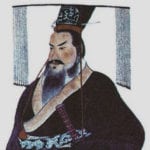 Music
Music  Music
Music  History
History 10 Less Than Jolly Events That Occurred on December 25
 Weird Stuff
Weird Stuff 10 Funny Ways That Researchers Overthink Christmas
 Politics
Politics 10 Political Scandals That Sent Crowds Into the Streets
 Weird Stuff
Weird Stuff Ten Bizarre Facts About The Doge Meme
 Our World
Our World 10 Ways Your Christmas Tree Is More Lit Than You Think
 Movies and TV
Movies and TV The 10 Coolest Stars to Set Sail on The Love Boat
 History
History 10 Things You Didn’t Know About the American National Anthem
 Technology
Technology Top 10 Everyday Tech Buzzwords That Hide a Darker Past
 Humans
Humans 10 Everyday Human Behaviors That Are Actually Survival Instincts
 Music
Music 10 Surprising Origin Stories of Your Favorite Holiday Songs
 History
History 10 Less Than Jolly Events That Occurred on December 25
 Weird Stuff
Weird Stuff 10 Funny Ways That Researchers Overthink Christmas
Who's Behind Listverse?

Jamie Frater
Head Editor
Jamie founded Listverse due to an insatiable desire to share fascinating, obscure, and bizarre facts. He has been a guest speaker on numerous national radio and television stations and is a five time published author.
More About Us Politics
Politics 10 Political Scandals That Sent Crowds Into the Streets
 Weird Stuff
Weird Stuff Ten Bizarre Facts About The Doge Meme
 Our World
Our World 10 Ways Your Christmas Tree Is More Lit Than You Think
 Movies and TV
Movies and TV The 10 Coolest Stars to Set Sail on The Love Boat
 History
History 10 Things You Didn’t Know About the American National Anthem
 Technology
Technology Top 10 Everyday Tech Buzzwords That Hide a Darker Past
 Humans
Humans 10 Everyday Human Behaviors That Are Actually Survival Instincts
10 Bizarre Calendars From History
The Gregorian, Islamic, Chinese, and maybe Julian calendars are the most popular calendar systems in use today. However, other, sometimes rather odd and unique, calendars have been used throughout history. Here are 10 such examples.
10 The International Fixed Calendar

The International Fixed Calendar has 13 months; each of which has 28 days. The months are named with the regular January–December, with a new month called “Sol” added between June and July. There would be a single, month-less day at the end of every year called “year day.” Independence Day would no longer be July 4, but Sol 16. Easter would always be on April 15, and every Christmas would be a Wednesday. Every year would start on a Sunday, and for the superstitious, every Friday would always be a 13th.
The calendar was made by Moses Cotsworth, a railway adviser who didn’t like how the Gregorian calendar was “scattered.” The calendar was popular among businessmen, particularly those into haulage and transportation. While it was never officially adopted by any country, it was used by George Eastman, who used it in his photography company—Kodak, from 1928–89. George Eastman popularized the calendar, hoping other businesses would also adopt it. He even opened an office inside his headquarters for the International Fixed Calendar League, an organization which wanted their calendar to replace the Gregorian calendar.
9 The Egyptian Calendars

The first calendar used by early Egyptians was a lunar calendar based on the rising and falling of the River Nile. This calendar ended up inaccurate because it provided an error of up to 80 days, prompting the Egyptians to introduce a solar calendar based on the star Sirius. The two calendars were used simultaneously, but they soon drifted apart, forcing the Egyptians to add an extra month to the lunar calendar once every three years.
Even with the extra month, the calendars were still out of sync, so the Egyptians introduced a new calendar called the “civil” or “civic” calendar, which was loosely based on the lunar calendar but was neither a lunar nor solar calendar. It had 365 days divided into 12 months. Each month had 30 days and an extra five days were added at the end of the year. Just like its predecessors, the civil calendar was also inaccurate. While the specific months of the lunar calendar fell in the same season every year, months in the civil calendar fell on any season. The Egyptians then introduced a new lunar calendar based on the civil calendar. The new lunar calendar was used to determine the day of religious celebrations, while the older lunar calendar was used for agricultural purposes.
8 The Mayan Calendars
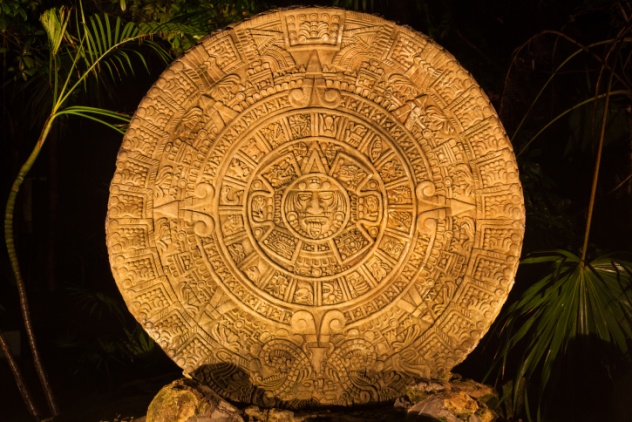
The Mayan calendar was actually made up of three different calendars: the Long Count (astronomical calendar), the Tzolkin (divine calendar), and the Haab (civil calendar). The Haab calendar had 365 days, divided into 19 months—18 20-day months and a five-day month. The Tzolkin, on the other hand, had 20 “periods,” with 13 days each. The Tzolkin was used in determining the days of Mayan ceremonies and religious activities. The Long Count was used to determine longer time frequencies known as the “Universal Cycle.” A universal cycle has 2.88 million days (about 7,885 years). Ancient Maya believed that the universe is destroyed and then rebuilt every 2.88 million days.
Dates in the Mayan calendar were calculated with the Tzolkin and Haab calendars. Both calendars were used to create a new calendar called “calendar round.” Interestingly, it was the Long Count calendar that led to the rumor that the Maya had predicted that the world would end on December 21, 2012, the day the last Great Cycle ended. The Maya never said that Earth would cease to exist on that date. Instead, a Great Cycle would end, and another would begin.
7 The Positivist Calendar
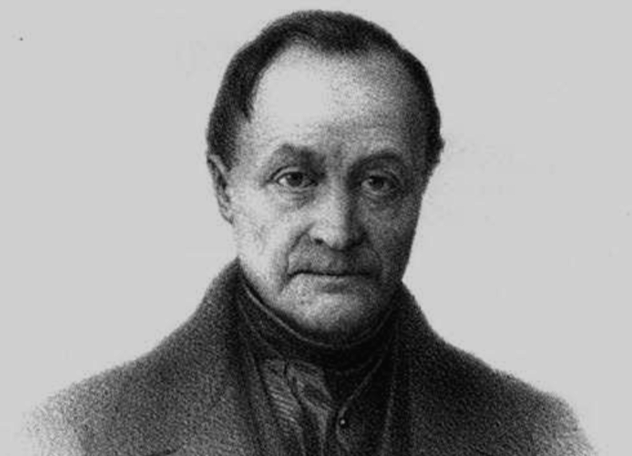
The Positivist calendar was intended to replace the Catholic calendar. It was invented in 1849, by August Comte. All its months had exactly 28 days, divided into four seven-day weeks. It had a standalone month-less day dedicated to all dead people at the end of every year. Every leap year would have an extra month-less day dedicated to women. Each day was named after an historic person or organization, and all months and years begin on Monday.
The first month of the year was named after Moses, the third was named after Aristotle, the fourth after Archimedes, the fifth after Caesar, the sixth after St. Paul, and the 10th after Shakespeare. The 14th day of Moses was named after Buddha, the 21st day of Aristotle after Socrates, and the seventh day of Gutenburg after Columbus. If the calendar had been adopted, the Gregorian calendar’s 1789 would be year 1, and 2000 would have been 212.
6 The Soviet Revolutionary Calendar
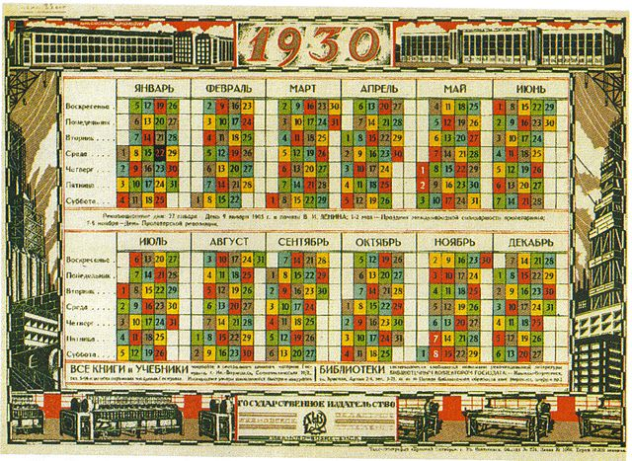
The Soviet “Revolutionary” calendar was introduced in the Soviet Union in 1929. The calendar did not change the year like several other calendars. Instead, it manipulated the weeks of the year, reducing the number of days in a week from seven to five. The number of weeks in a month was also increased from the usual four to six. At the end of every year were five or six days that did not have a month. While the calendar lasted, the Soviet Union experienced February 30. Each day on the calendar was represented with either a color or Roman numeral. Workers, both government and non-government, were issued a number or color. They were to observe a day off on the day that fell on their number or color.
The results of the new calendar were disastrous. While it did increase productivity as intended (80 percent of the country was working at any given time), it segregated families and friends. A wife could have her off on a blue day, while the husband had his on a red and the children on a green. Workers were generally demoralized, and machines could not be routinely maintained since they were used almost daily. To counter this new problem, the Soviets introduced a new calendar with six-day weeks. Everyone worked for five days every week, and there was a general day off for everyone. The calendar was intended to increase workers’ productivity, although it also had some roots in exterminating religion. The calendar was finally abolished on June 26, 1940.
5 The Chinese Calendar

The Chinese calendar is a lunisolar calendar, meaning that it is calculated based on the position of the Sun and the Moon. A regular year has 12 months and 353–355 days, while a leap year has a whole extra month, which brings the year to 383–385 days. The leap month is added once roughly every three years, and it shares the same name as the previous month. Although the calendar is still in use in China, it is mostly used to calculate the days of Chinese ceremonies and weddings, while the Gregorian calendar is used for almost everything else.
Years are not counted in numbers like in other calendars. Instead, they are named after one celestial term and one terrestrial body over a 60-year cycle. The celestial terms, 10 in number, have no equivalent word in English. The terrestrial bodies are the 12 animals that comprise the Chinese zodiac signs. And just like almost every other calendar out there, the Chinese calendar has its own errors. In the year 2033 (Gregorian calendar), the leap month will be added after the seventh month instead of the 11th, which is very unusual.
4 The Ethiopian Orthodox Calendar

Ethiopia celebrated the new millennium on September 12, 2007, seven and a half years behind the West. This is because they use the Coptic Orthodox calendar, which is used by the Coptic Orthodox Church and is similar to the Jewish calendar. The calendar has 13 months of 30 days each, and leap years have an extra month of five or six days. The calendar was used by the West prior to 1582, when they changed to the Gregorian calendar.
Ethiopia did not switch to the Gregorian calendar because it was conservative and overprotective of its religion. Besides, they were located far from other major countries of the world and might have not been informed when the change of calendar took place. To prevent confusion between the Orthodox and Gregorian calendars, all calendars in Ethiopia list the date based on both the Orthodox and Gregorian calendars. The major challenge Ethiopians face with using two calendars is that a leap year for one calender is not necessarily a leap year in the other.
3 The French Revolutionary Calendar

The French Revolutionary calendar was also called the French republican calendar. It was used in France from October 24, 1793, until January 1, 1806, when it was abolished. It was readopted around 1871, before being abolished yet again. The calendar was a failed attempt to “de-Christianize” France. It was first introduced on October 24, 1793, a little over a year after the French revolution. Because of this, there was no year 1. Instead, the calendar began from year 2 .
It had 12 months, each of which had three decades (rather than weeks) of 10 days each. Five month-less days (or six in the case of leap years) were added at the end of the year. Each day of the year was named after seeds, trees, flowers, fruits, tools, and animals. Of all the 10 days in the decade, only the last day was regarded as the day for rest. The remaining nine days were strictly for work.
Leap years were often added to make the New Year begin on the autumnal equinox, but this simply complicated issues, as the autumnal equinox was difficult to predict. The calendar soon got out of sync with other calendars, and several adjustments were planned by year 20 to correct the calendar. These adjustments never came, as the calendar was abolished in year 14.
2 The Roman Calendar
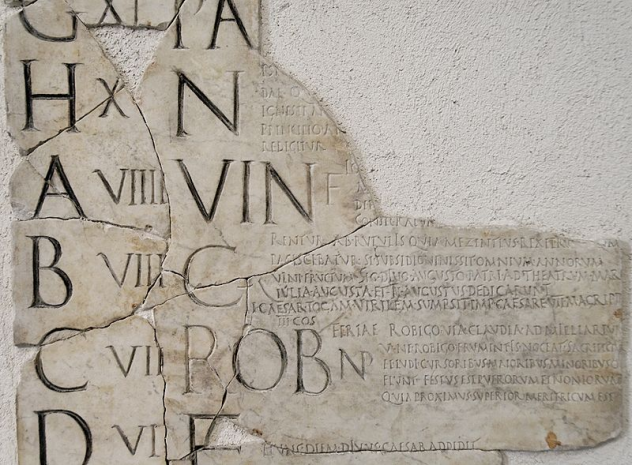
The Roman calendar is a perfect example of what a calendar shouldn’t look like. Also called the “pre-Julian” calendar, it was created by King Romulus when Rome was founded. It had 10 months, totaling 304 days, and an additional 61 days that were not assigned to months or weeks. Because the months were not in sync with the seasons, King Numa added two extra months, Ianuarius (January) and Februarius (February) to bring the months to 12. An extra month could also be added at the behest of the pontifex maximus, a Roman high priest.
Most pontifex maximi added the extra month for their own political gains. Some were even bribed to add or reduce the length of the year. Leap years were also deliberately avoided because they were believed to bring bad luck. Julius Ceasar later introduced the Julian calendar after he became the pontifex maximus. However, the new calendar could not be immediately adopted because of the inaccuracies in the Roman calendar. So, 46 BC ended up with 15 months, totaling 445 days. That year was named “the last year of confusion,” and the Julian calendar finally started in 45 BC.
1 The Aztec Calendar
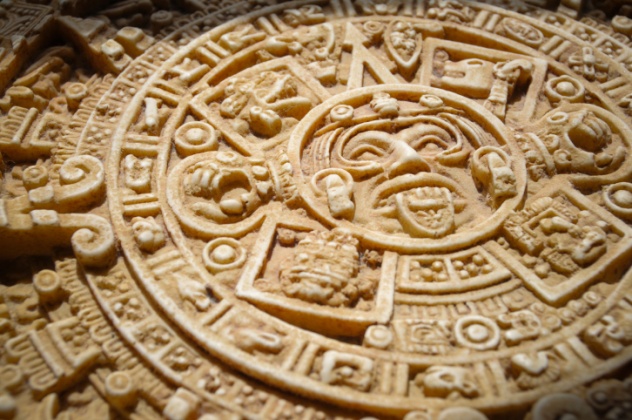
The Aztec calendar was made up of two different calendars—the Xiuhpohualli and the Tonalpohualli. The Xiuhpohualli had 365 days divided into 18 months of 20 days each. Five extra days, which were considered unlucky, were added at the end of the year, and 12 days were added once every 52 years. The Tonalpohualli, on the other hand, had 20 months divided into 13 days, bringing its days to 260. Each of the 260 days was associated with a number or sign and dedicated to a god.
The two calendars became equal once every 52 years, during which the Aztecs believed the world would be destroyed. To prevent the impending destruction, they performed a 12-day ritual called the new fire festival to “bind up” the years. All fires burning in the city would be extinguished on the first day of the festival, and they would remain like that till the 12th day, when a human sacrifice would be offered and a new fire lit. This sacrifice was to ensure that the Sun would keep rising for the next 52 years.
Elizabeth owns a Facebook and Twitter page where she posts interesting facts several times a day. You can like the page on Facebook here and also follow her on Twitter at twitter.com/factshood. Thank you.


